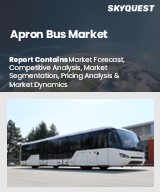
Report ID: SQMIG25C2184
Skyquest Technology's expert advisors have carried out comprehensive research on the apron bus market to identify the major global and regional market trends and growth opportunities for leading players and new entrants in this market. The analysis is based on in-depth primary and secondary research to understand the major market drivers and restraints shaping the future development and growth of the industry.
Growth of Airport Facilities and Services to Accommodate Increasing Demand
Government Policies and Incentives Fueling Market Growth
Higher Jet Bridge Use Reduces Apron Bus Services Demand
Maintenance and operational downtime problems Affecting Efficiency and Performance
REQUEST FOR SAMPLE
Global Apron Bus Market size was valued at USD 475.66 Million in 2023 and is poised to grow from USD 524.22 Million in 2024 to USD 1,140.99 Million by 2032, growing at a CAGR of 10.21% during the forecast period (2025-2032).
The apron bus industry is competitive, and market leaders are prioritizing technological advancement, sustainability, and operational effectiveness. Market leaders such as BYD, Volvo, and COBUS Industries are investing in hybrid and electric apron buses to meet increasing environmental regulations. GPS tracking, autonomous driving features, and real-time passenger information systems are being adopted by most firms to improve user experience and efficiency of operations. In addition, airport operators are increasingly emphasizing sustainable solutions, providing room for new market entrants. Airport operators and manufacturers are collaborating on most instances, with manufacturers adjusting to accommodate individual airport needs. The industry is also driven by expanding airport infrastructure projects, providing a chance for apron bus adoption. Competitive forces are driven by price sensitivity, technological innovation, and quality of customer service. 'AB Volvo (Sweden)', 'AMSS GSE (United Kingdom)', 'Ashok Leyland (India)', 'BYD Company (China)', 'BMC Otomotiv Sanayi VE Ticaret AS (Turkey)', 'COBUS Industries (Germany)', 'Kiitokori OY (Finland)', 'MCV Group (Egypt)', 'Nandan GSE (India)', 'Neoplan (Germany)', 'Panus Assembly (Thailand)', 'Proterra (United States)', 'Solaris Bus & Coach sp. z o.o. (Poland)', 'Sutlej Motors (India)', 'TAM - Europe (Slovenia)', 'Aeromobiles (India)', 'Mallaghan (G.A.) Inc. (United Kingdom)', 'Xiamen King Long United Automotive Industry (China)', 'Xinfa Airport Equipment (China)', 'Yutong Bus Co. Ltd (China)'
Expansion of airport facility and services is among the key drivers of the apron bus market, as airports grow to support growing passenger traffic and increased air traffic volumes. These include expansion of extra terminals, runways, and off-terminal stands, which require efficient solutions for ground transport. Apron buses are used to bridge the gap between terminals and planes, ensuring smooth operations and greater passenger mobility through increasingly complex airport systems.
What Makes Europe a Leader in Apron Bus Market?
Want to customize this report? This report can be personalized according to your needs. Our analysts and industry experts will work directly with you to understand your requirements and provide you with customized data in a short amount of time. We offer $1000 worth of FREE customization at the time of purchase.
Feedback From Our Clients

Report ID: SQMIG25C2184
sales@skyquestt.com
USA +1 351-333-4748